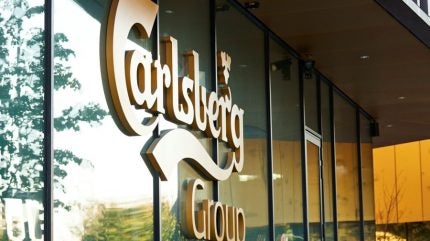
Shares in Carlsberg rose today (7 February) after the beer giant lifted its long-term targets for underlying sales and EBIT.
However, the Tuborg and Brooklyn Pilsner brewer issued a forecast for 2024 organic EBIT that was below analyst consensus expectations.
Carlsberg’s recently-appointed CEO Jacob Aarup-Andersen said the Denmark-based group plans to “step up commercial investments” in 2024 to boost sales.
Aarup-Andersen said the brewer expects to again see costs rise again this year and indicated the company expects consumer sentiment to remain “subdued” in China and parts of Europe. Sporting events in Europe this year could boost volumes, he added.
“Guidance for 2024 is somewhat more cautious than we were expecting, targeting 1-5% organic EBIT growth,” AllianceBernstein analyst Trevor Stirling wrote in a note to clients today. “Consensus is at +7.5% and will have to come down slightly, although Carlsberg has a track record of guiding cautiously to beat expectations.”
Stirling added: “Carlsberg upgraded the long-term guidance from 3-5% organic sales growth to 4-6%, with some margin expansion. The new long-term guidance is a positive.”
In 2023, Carlsberg saw its revenue rise 4.7% to DKr73.59bn ($10.62bn). On an organic basis, revenue was up 9.2%. Organic revenue per hectolitre grew 10%. Volumes, however, dipped 0.5% organically.
Volumes increased 3.7% in Asia on an organic basis, amid growth in China, India and Vietnam.
“When we look at last year, there’s no doubt that the Chinese market was was difficult. It also became more difficult during the year,” Aarup-Andersen said. “When we look at the overall market in China, it was down. When we look at our own performance, we did well in terms of a good, mid-single digit volume growth in China. That's a function of the fact that we are continuing to take market share.”
He added: “Looking into ‘24 and beyond we cannot be specific around market-specific guidance but there’s no doubt that we are expecting a good volume growth again in the coming year. We are expecting to see continued good growth in China, of course, weighed down somewhat by the fact that the Chinese consumer is not in a great place. No doubt that the Chinese market will start in the same way as it ended, which means a subdued consumer environment. We are not going to predict when that turns but we are optimistic that that we can continue to grow in that market.”
In western Europe, organic volumes fell 2.3%. They were down 4% in Carlsberg’s central and Eastern Europe region.
“When I look at ‘24, we are not seeing any step change in consumer behaviour in the near term horizon,” the Carlsberg CEO said with regard to Europe. “We do expect a continued relatively subdued consumer in the start of the year. When we get towards the middle of the year, we do have first of all easier comparisons compared to last year, which will help our growth numbers and then, at the same time, we also have some major sporting events in Europe, which will inevitably have a positive impact on our volume.”
Asked by Just Drinks if Carlsberg expected to see its volumes grow in western Europe this year, Aarup-Andersen said the company predicts “stable to slightly growing volumes”.
He added: “That’s both due to easy weather comps in Q3 and also expected a somewhat expected improvement in terms of the consumer sentiment. There is real wage growth in a number of our markets in ‘24 as inflation comes down and then those sports events. We don't have any euphoric expectations but stable to slightly growing volumes.”
Reported operating profit fell 3.2% to DKr11.11bn, impacted by currencies. On an organic basis, operating profit rose 5.2%.
Adjusted net profit for continuing operations was down 5% at DKr7.43bn, impacted by higher finance costs and currency movements, Carlsberg said.
As Carlsberg seeks to up its investment in sales and marketing, the company is planning to look at areas including its brewing operations and procurement to control costs.
“We’re talking about a significant step up in our commercial investment,” Aarup-Andersen said.
“Savings will predominantly be coming out of the supply chain. We’re not closing breweries … but we are going to be driving a significant efficiency programme across our supply chain, which basically means our breweries and our logistics.
“The first major lever is procurement. We are putting significant resources in data and analytics behind working smarter and more efficiently in our procurement. The second element is operational efficiency in our breweries … to drive operational efficiency more broadly across our breweries by benchmarking, using data analytics and digitising parts of our value chain.
“The third element is looking at how we produce and package our products more broadly in terms of the efficiencies from having standardised packaging.”
Despite falling prices of some inputs, Carlsberg expects its total cost base to rise in 2024 and therefore will look to again up prices.
“We’re not seeing any let-up in terms of the overall cost picture of the business. There is no doubt that there are categories where prices have come down. If you look at commodities, aluminium and barley has come down but at the same time, sugar, glass, etc. are up. There is a lot of sticky inflation across the cost base, both indirectly via suppliers and more directly the products and services we procure,” Aarup-Andersen said.
“We don’t see the same inflationary levels that we saw last year. Things are coming down but that’s the increase that is coming down. The absolute amount of cost is still going up. For specific markets, we don’t talk about but overall pricing this year will have to go up to probably the overall cost increases.”



